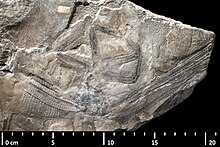
Meganeura is a genus of extinct insects from the Late Carboniferous. They resembled and are related to the present-day dragonflies and damselflies, and were predatory, with their diet mainly consisting of other insects. The genus belongs to the Meganeuridae, a family including other similarly giant dragonfly-like insects ranging from the Late Carboniferous to Middle Permian. With single wing length reaching 32 centimetres (13 in) and a wingspan about 65–75 cm (2.13–2.46 ft), M. monyi is one of the largest-known flying insect species.

The family Prophalangopsidae are insects belonging to the order Orthoptera. They are the only extant members of the superfamily Hagloidea. There is only one extant genus in North America, where they are known as grigs, four genera in Asia, and many extinct genera.

Ensifera is a suborder of insects that includes the various types of crickets and their allies including: true crickets, camel crickets, bush crickets or katydids, grigs, weta and Cooloola monsters. This and the suborder Caelifera make up the order Orthoptera. Ensifera is believed to be a more ancient group than Caelifera, with its origins in the Carboniferous period, the split having occurred at the end of the Permian period. Unlike the Caelifera, the Ensifera contain numerous members that are partially carnivorous, feeding on other insects, as well as plants.
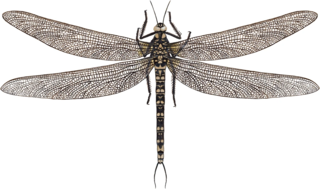
Meganisoptera is an extinct order of large dragonfly-like insects, informally known as griffenflies or (incorrectly) as giant dragonflies. The order was formerly named Protodonata, the "proto-Odonata", for their similar appearance and supposed relation to modern Odonata. They range in Palaeozoic times. Though most were only slightly larger than modern dragonflies, the order includes the largest known insect species, such as the late Carboniferous Meganeura monyi and the even larger early Permian Meganeuropsis permiana, with wingspans of up to 71 centimetres (28 in).
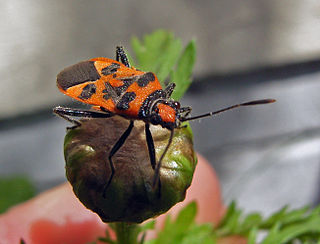
Coreoidea is a superfamily of true bugs in the infraorder Pentatomomorpha which includes leaf-footed bugs and allies. There are more than 3,300 described species in Coreoidea.

Namurotypus is an extinct genus of griffinfly with a single described species Namurotypus sippeli. It inhabited the large swamps of the Carboniferous period. Namaurotypus had a 15 cm long forewing and did not have secondary male sex organs as in modern dragonflies.

Alderflies are megalopteran insects of the family Sialidae. They are closely related to the dobsonflies and fishflies as well as to the prehistoric Euchauliodidae. All living alderflies – about 66 species all together – are part of the subfamily Sialinae, which contains nine extant genera.

Libelluloidea is a superfamily of dragonflies.
Bohemiatupus is an extinct genus of griffinfly in the family Meganeuridae and containing a single species Bohemiatupus elegans. The species is known only from the Late Carboniferous, Bolsovian stage, Kladno Formation near the village of Radnice in the Radnice Basin, Czech Republic.
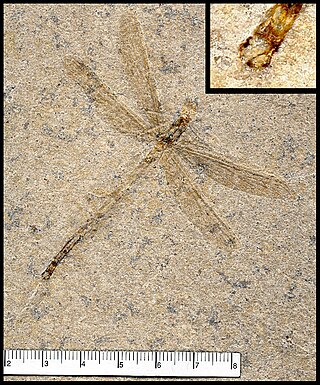
The Tarsophlebiidae is an extinct family of medium-sized fossil odonates from the Upper Jurassic and Lower Cretaceous period of Eurasia. They are either the most basal member of the damsel-dragonfly grade ("anisozygopteres") within the stem group of Anisoptera, or the sister group of all Recent odonates. They are characterized by the basally open discoidal cell in both pairs of wings, very long legs, paddle-shaped male cerci, and a hypertrophied ovipositor in females.

Calopterygoidea is a superfamily of damselflies in the order Odonata.
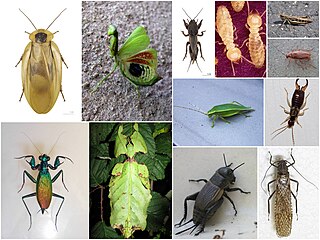
The cohort Polyneoptera is one of the major groups of winged insects, comprising the Orthoptera and all other neopteran insects believed to be more closely related to Orthoptera than to any other insect orders. They were formerly grouped together with the Palaeoptera and Paraneoptera as the Hemimetabola or Exopterygota on the grounds that they have no metamorphosis, the wings gradually developing externally throughout the nymphal stages. Many members of the group have leathery forewings (tegmina) and hindwings with an enlarged anal field (vannus).

Tettigoniidea is an infraorder of the order Orthoptera, with six extant families.
Locustopsidae is an extinct family of grasshoppers in the order Orthoptera. There are about 17 genera and more than 60 described species in Locustopsidae.

Steleopteridae is a family of extinct winged damselflies whose fossils have been found in modern Germany, Great Britain and Kazakhstan, and which lived at the end of the Jurassic and the beginning of the Cretaceous.
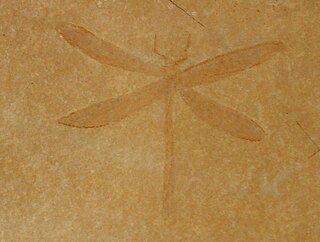
Steleopteon is a genus of extinct winged damselflies whose fossils have been found in modern Germany, and Great Britain, and which lived at the end of the Jurassic and the beginning of the Cretaceous.

Permopsocida is an extinct order of insects known from the Carboniferous (Moscovian) to the Mid-Cretaceous. It is part of Paraneoptera, alongside bark lice, bugs and thrips. Within Paraneoptera it is considered to be closer to the clade containing bugs and thrips rather than bark lice, with an estimated divergence during the Late Carboniferous. The group was first named as a suborder by Robert John Tillyard in 1926, and was raised to a full order by Huang et al. in 2016. It is currently divided up into three families, Psocidiidae which is known from the Permian to Liassic. Permopsocidae which is only known from the Permian, and Archipsyllidae, which is known from the Late Triassic to mid-Cretaceous (Cenomanian). While most members of the group are known from compression fossils, several members of Archipsyllidae are 3 dimensionally preserved in Burmese amber, which has helped clarify the morphology and phylogenetic position of the group. The morphology of the mouthparts suggests that they were capable of suction feeding and chewing, with preserved angiosperm pollen grains in the gut of Psocorrhyncha suggesting that at least some members of the group were pollenivorous.

Elcanidae are an extinct family of Mesozoic and early Cenozoic orthopterans. Members of the family are distinguished by the presence of spurs on the distal part of the metatibia, unique among orthopterans, these have been suggested to have been used for controlling gliding, swimming aids, or for jumping on water. The group combines characteristics from both major groups of orthopterans, with long antennae and nymphal morphology similar to Ensifera, but with wing venation and adult morphology more similar to Caelifera. Elcanidae is part of Elcanoidea, which is thought to have diverged from living orthopterans by the beginning of the Permian, around 300 million years ago. The family also includes Permelcanidae, known from the Early-Late Permian. The relationship of Elcanoidea to Ensifera and Caelifera is currently unresolved. Elcanids are known from the Late Triassic to Paleocene of Eurasia, North and South America. Some members of the group exhibited aposematic coloration.
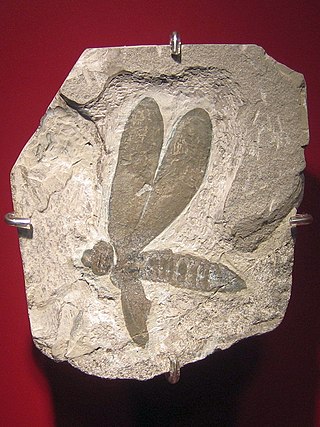
Caloneurodea is an extinct order of polyneopteran neopteran insects in the superorder Orthopterida. Caloneurodea is known from fossils found in North America, Europe, Russia, and Asia and had a paleogeographic range confined to Laurussia.

Paoliida is an extinct order of winged insects that lived in the late Paleozoic. Historically, both their systematic position and composition were controversial – for instance they had been considered as palaeodictyopterans, as basal Neoptera, or as stem-group of Pterygota – but recent studies have resolved them as the sister group of Dictyoptera.
